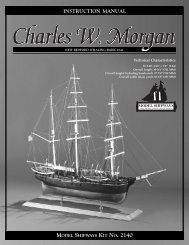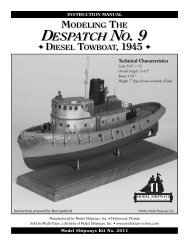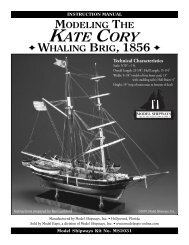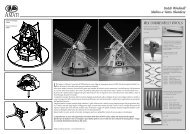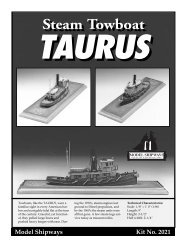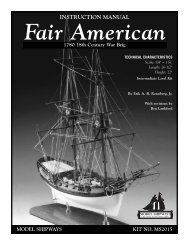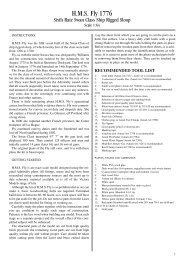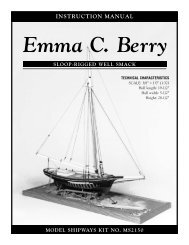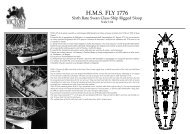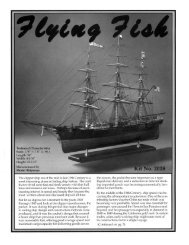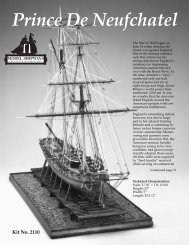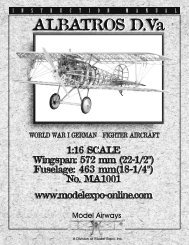download benjamin latham instruction manual
download benjamin latham instruction manual
download benjamin latham instruction manual
You also want an ePaper? Increase the reach of your titles
YUMPU automatically turns print PDFs into web optimized ePapers that Google loves.
Grub (or Great) Beam: often painted white for visibility at<br />
night.<br />
Deck: could be light grey, although some vessels’ decks were<br />
painted Pea Green. Sometimes great circles were swept around<br />
the quarter bitts, at the grub beam, and abreast the foremast.<br />
The color used for the deck was then painted within the radii<br />
(see perspectives drawings on sheet 3 or 4––these are the dark<br />
areas shown on the deck around fiferails, windlass, and along<br />
the waterways).<br />
Waterways: Outside the previously mentioned circles, the waterway<br />
color was painted (this could be white to match the bulwarks,<br />
or a deep prussian blue, which was then quite popular).<br />
In painting the waterways, the caulking line between it and the<br />
deck plank was rigidly followed, even where planks were<br />
nibbed, giving a sawtooth effect along some stretches. Beyond<br />
the arcs of the circles, this did not matter.<br />
Ironwork: was generally black, but sometimes a benign soul<br />
would paint the hawse pipe linings and lips a bright red. The<br />
diaphragm pumps were similarly treated; sometimes they<br />
were a bright red all over; other times they would be black<br />
with only the insides of the bowls and spouts painted red.<br />
Anchors: may be painted black or left a red-lead color, but<br />
their stocks were tarred a glossy dark brown when the tar was<br />
fresh. The anchor chain sat in a rusty heap in the chain box and<br />
may be “antiqued” accordingly on the model.<br />
Windlass Barrel: often had its ironwork blacked. The barrel<br />
inside the riding bitts was oiled or black-varnished, making it<br />
very dark and somewhat glossy. The windlass heads, however,<br />
were often painted white, ironwork and all. In later years,<br />
many windlass barrels were completely painted, usually white.<br />
Hub, Rim & Spokes of Stoddart Steering Wheel: could be<br />
painted grey or white, the mahogany spokes would have been<br />
oiled and their brass caps polished bright.<br />
Bowsprit: may be black or white inboard, and black outboard,<br />
with the iron bands black and the pole white. All gaffs and<br />
booms should be salmon-buff with white tips.<br />
Masts: The lower masts were painted white from the deck to<br />
the boom saddle or the gooseneck; the mastheads were often<br />
white, but some vessels, including Latham, had buff mastheads<br />
with black ironwork. The tips of the mastheads, which protruded<br />
above the caps, were often white-leaded. The topmasts at the<br />
doublings were the color of the lower mast heads; their poles<br />
were generally white. All blocks, regardless of location, would<br />
have been painted the same color as the spars: white or buff.<br />
The hoists of both lower masts and topmasts, over which the<br />
gaffs and mast hoops traveled, were “slushed” or coated with a<br />
mixture of tallow and grease. This allowed gaffs and hoops to<br />
slide up and down with a minimum of friction. The color was a<br />
greyish-umber which darkened when its greasy substance<br />
caught dirt and grime.<br />
Seine Boat: was usually painted white with copper anti-fouling<br />
paint below the waterline. Its inboard works should be all<br />
grey or white.<br />
Gunwales & Gunwale Strakes: were generally a bright yellow,<br />
set off by a red stripe along the lower side.<br />
Dory: any shade of buff, grey or green with light grey inboard.<br />
Oars: oiled natural, but inevitably turned a weathered grey.<br />
Lanterns: Port lantern board is red and the starboard is green.<br />
FIG. 1b – Scribing the Waterline<br />
Is the model perfectly level<br />
Pencil<br />
or scriber<br />
Wood Block<br />
9



